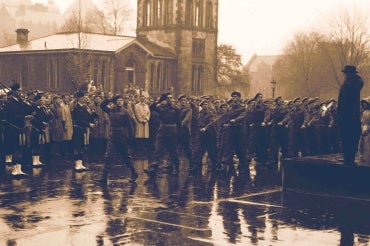November 11: U of T Remembers

Published: November 9, 2016
On Friday, the Soldiers’ Tower memorial at U of T will be the site of one of the city’s most widely attended Remembrance Day services with its carillon of 51 bells ringing out for fallen soldiers.
It is one of several Remembrance Day ceremonies that will take place across U of T’s three campuses, honouring the service and sacrifice of thousands of members of the U of T community, including more than 1,000 students, alumni and faculty who gave their lives in the First and Second World Wars.
The tower and its museum came out of volunteer efforts from U of T’s Alumni Association. U of T archivist Harold Averill says the idea for a tower with bells, honouring fallen soldiers came from a young woman who suggested it during a meeting in 1918, although the 143-foot tall Gothic tower would take another six years to be built.
Read more about the history of Soldiers' Tower in The Globe and Mail
Many of the names etched in the tower’s memorial wall came from memorials that initially appeared at University College and Victoria College. Returning students took on the task of raising funds for them. A history professor was seconded to pull together the names of all fallen soldiers from across the university.
Inside the museum, you can learn about notable alumni including:
- Norman Bethune, who served in WWI, was a frontline surgeon during the Spanish Civil War and rose to fame for bringing modern medicine to rural China.
- Wilmot Amos Burgess, an African-American who served in the American Expeditionary Force.
- Lawren Harris, a member of the Group of Seven artists.
- John McCrae, author of the poem In Flanders Fields.
- Thain Wendell MacDowell, awarded the Victoria Cross for his actions at Vimy Ridge. A machine gun captured by him is in the museum.
- Lester Pearson, who survived WWI and later became Prime Minister.
- Nursing Sister Lily Denton Keys, the only woman listed on the First World War Memorial Wall. A graduate of Victoria College, she contracted pneumonia while on duty.
- Co-discoverers of insulin, Sir Frederick Banting, who served in World War I and was killed in WWII while on a research mission, and Charles Best, who survived WWII.
- Gordon Arthur Kidder and George Edward McGill who escaped from a German POW camp – made famous in the movie, The Great Escape – but were later recaptured and killed by the Nazis.
U of T News presents a few of the stories honouring the brave women and men who have served our country in uniform:
Remembering the veterans of Sunnybrook

An interview with physical therapy student Danny Slack, who spent five weeks interning at Sunnybrook Veterans Centre.
In Memoriam: remembering the First World War at U of T

Archivist Harold Averill discusses the war that changed the world.
In Flanders Fields: why the iconic poem by U of T alumnus endures, 100 years later

As Canadians commemorate Remembrance Day this year, many will reflect on the solemn beauty and eloquent simplicity of the iconic war poem, In Flanders Fields. This is the 100th anniversary of the poem written by University of Toronto alumnus John McCrae, a Canadian doctor who was in the trenches during World War I.
We will do our share
U of T archivist Loryl MacDonald takes us through the Fisher Library's exhibition, We Will Do Our Share: The University of Toronto and the Great War.
Dr. Homer Tien: from the battlefield to the ER

Dr. Homer Tien, recipient of the Order of Military Merit and assistant professor at U of T and director, trauma services, at Sunnybrook Health Sciences Centre, recalls his exceptional advancements.
Canadian Forces: alumna retires after serving as surgeon general

Few people have served nearly four decades in the Canadian Forces. Fewer of these are doctors. Fewer still are women. And only one of these – University of Toronto medicine graduate Dr. Hilary F. Jaeger— has retired with the rank of brigadier general after serving as surgeon general of the Canadian Forces.
What can civilian hospitals learn from the military? Just ask this high school dropout turned trauma surgeon

Dr. Andrew Beckett is a highly credentialed trauma surgeon who has spent nearly two decades in the Canadian Forces – and whose work in war zones has led him to ask questions that never occur to most of his research colleagues back home.



